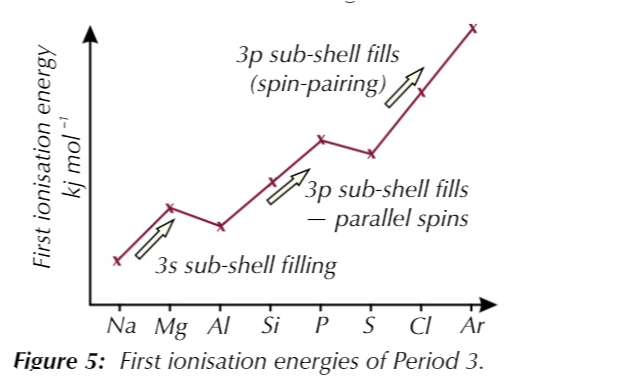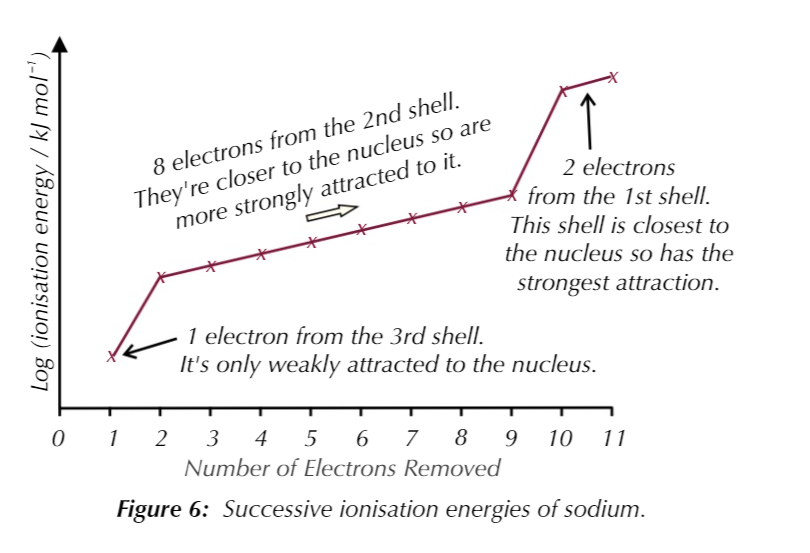ATOMIC STRUCTURE PART 2
1/30
There's no tags or description
Looks like no tags are added yet.
Name | Mastery | Learn | Test | Matching | Spaced |
|---|
No study sessions yet.
31 Terms
TOF KEY EQUATION
mass= Ar÷Avogadro
mass spectrum
a type of chart produced by a mass spectrometer that shows information about the sample
if the sample is an element
each line represents the isotopes. Y-axis gives % abundance of ions. X-axis gives mass/charge ratio
mass spectrums from electrospray ionisation, each peak would be 1 unit greater than the actual relative mass of each
because a H+ has been added to for the +1 ion, the mass/charge ratio of isotope
mass spectrums from electron impact ionisation, each peak is the same as the relative mass of each isotope
because an electron has been knocked off to form +1 ions. the mass/charge ration of
calculating relative atomic mass
for each peak, read the % from the y-axis and multiply it with the Mass/charge ratio
add up these totals
divide by 100
electron shells have principal quantum numbers
the further a shell is from the nucleus the higher its energy and the larger its principal quantum number
electron configuration 3 rules
electrons fill up the lowest energy sub-shell first
electrons fill up orbitals in a sub-shell singly before they start sharing
for the configuration of ions from the S and P blocks of the periodic table, just add or remove electrons to or from the highest occupied sub-shell
chromium electron configuration
1s2 2s2 2p6 33s2 3p6 3d5 4s1
copper electron configuration
1s2 2s2 2p6 3s2 3p6 3d10 4s1
s block elements
can easily lose 1 or 2 electrons to form a positive ion with an inert gas configuration (full outer shell)
p block elements
can gain 1,2 or 3 electrons to form a negative ion with an inert gas configuration (full outer shell)
groups 4 to 7
can also share electrons when they form covalent bonds
first ionisation energy
the energy needed to remove 1 mole of electron from each atom in 1 mole of gaseous atoms to form 1 mole of gaseous 1+ ions
ionisation energies important points
must always use the gas symbol
always refer to 1 mole of atoms
the lower the ionisation energy the easier it is to form a positive ion
factors affecting ionisation energy
nuclear charge
distance from nucleus
shielding
nuclear charge
the more protons there are in the nucleus the more positively charged the nucleus is and the stronger the attraction of the electrons
distance from nucleus
the greater the distance of the outer electron from the nucleus the weaker the attraction
shielding
the greater the number of electrons between the outer electrons and the nucleus the weaker the attraction
ionisation is always an endothermic reaction
because you must put in energy to remove an electron from an atom or molecule
second ionisation energy
energy needed to remove an electron from each ion in 1 mole of gaseous 1+ ions to for 1 mole of gaseous 2+ ions
second ionisation > first ionisation
because electrons are being removed from a positive ion which requires more energy
successive ionisation energy

first ionisation energy decreases down group 2

evidence electron shells exist
elements going down group 2 have 1 more electron shell between the nucleus and the outer electron
this increases the distance between them which reduces the nuclear attraction
ionisation trend across period 3

ionisation trend across periods…
…generally increases because the proton number increases and the shielding effect stays the same
why does MAGNESIUM have a HIGHER ionisation energy than ALUMINIUM
aluminium’s outer electron is on 3p rather than 3s so electrons are generally further from the nucleus
3p orbital has additional shielding provided by 3s
why does PHOSPHORUS have a HIGHER ionisation energy that SULFUR
phosphorus and sulfur both have electrons in 3p however the first electron taken in phosphorus’ sub-shell is from a singly-occupied orbital
the first electron taken in sulfur is from an orbital containing 2 electrons
the repulsion between the 2 electrons makes it easier to remove from shared orbitals

1 electron from the 3rd shell and 11 electrons in total, ITS SODIUM
within each shell, successive ionisation energy increases…
…because electrons are being removed from increasingly positive ions, there’s less repulsion among the remaining electrons so they’re more strongly attracted to the nucleus